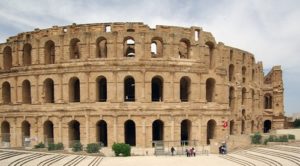By the 3rdC the Roman city of Thysdrus was the richest city in North America at the centre of a network of roads distributing goods between the coast and the interior. It was an important centre for manufacture and export of olive oil. The remains of the amphitheatre reflect this wealth and status. It was the third largest amphitheatre in the Roman World. It was a major undertaking to build as the stone quarries were 30km away. Although some of the stone was robbed for building and part of the walls destroyed in 1850 when the forces of the Bey put down a rebellion against rebels based in the amphitheatre, it remains an impressive building.
We knew it was big but didn’t realise just how big. It dominates the whole of the town. It had a capacity of 43,000 which was more than the total population of El Jem and people from the surrounding area would travel to watch the games.
Av Habib Bourguiba, the main street in El Jem leads to the amphitheatre. The 10’ high metal railing surrounding the site pale into insignificance. The ticket office is a wooden hut and there are a few tourist shops inside the perimeter fence. There was a sign advertising audioguides in different languages but when we asked about them the ticket office said ‘closed’.
From the outside the amphitheatre seems to be made of two separate walls linked by rough arches. Much of the rough masonry between the two which would have supported the tiers of seats has gone. There are two big ceremonial entrances with smaller entrances giving access to the different areas of seating. Part still stands to five tiers of arches round the outside. Steps lead down into the underground passageways with chambers where gladiators, charioteers, animals and victims waited their turn. Two sloping passages from the basement allowed gladiators and animals to be brought into the galleries below the arena. The square holes in the arena beside the central passage way contained and elaborate system of lifts which hoisted the animals in cages into the arena which could be opened safely using pulleys from below.
Two tiers of seats have been reconstructed where the outer walls were destroyed in 1850. These are accessed by walkways through the walls and stairs. The lowest seats nearest the action were for the elite and were separated by upright slabs of marble from the seats above.
The seats around the rest of the arena no longer exist although it is possible to walk along the arched passageways through the walls which gave access to the seats. There are remains of the rough masonry which supported the different tiers. It is possible to see the small triangular marks left in the huge stone blocks by the clamps used to lift the stones into place. Steps inside the walls climb up to the different levels. There are good views out through the outer archways across El Jem.
This really is a ‘must see’ on the tourist itinerary. Allow at least 90 minutes to do justice to the site. El Jem itself can be missed but do go the the Museum (joint ticket with the amphitheatre) and go and find the remains of the two older amphitheatres next to it.








